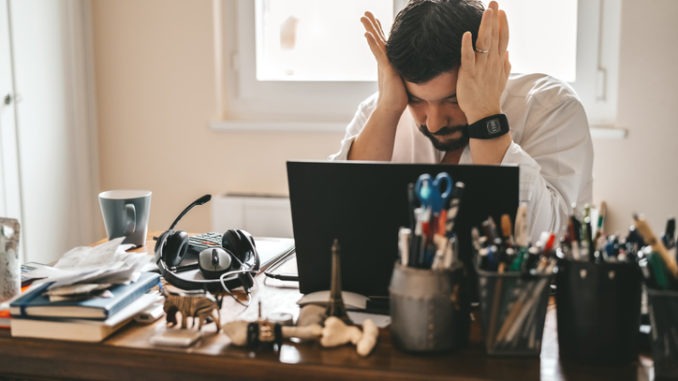
We might be working from home, but that doesn’t mean we can’t burn out from stress. The feeling might be a little different from what we’re used to, though
CREDIT: This is an edited version of an article that originally appeared on Huffington Post
Pop-up offices have appeared in bedrooms across the UK, so the boundaries between work and personal lives are increasingly blurred. It’s all too easy to check emails at 9pm because your laptop is within reach, or to skip a lunch break because your head is deep in a project. And while you might not realise it, it’s also all too easy to burn out.
“Working from home provides little opportunity for variety in your working day,” says Lucy Fuller, a UKCP-accredited psychotherapist. “There’s little chance for face-to-face, non-work social interaction, and it comes with an intensity that would usually be broken up by travelling and dawdling on your way to work, in your lunch period and also going to meetings outside your place of work.
“Our days are, therefore, becoming grey and our brains are burning and clouding from sitting in front of a screen for so long. We’re effectively trapped in this way of work without a definite end point to look forward to.”
Psychotherapist Philip Karahassan, a member of the British Association for Counselling and Psychotherapy (BACP), doesn’t think people know they can burn out while working from home. “People usually see it as a more relaxing work day, where they can do work at their own pace,” which might mean they’re hurtling headfirst into it.
What actually is burnout?
Last year, burnout was classified by the World Health Organisation (WHO) as an ‘occupational phenomenon’, legitimising the experiences of many who’ve fallen prey to the problem. It’s also known as ‘vital exhaustion’.
“Burnout is a syndrome conceptualised as resulting from chronic workplace stress that has not been successfully managed,” says WHO. It’s characterised by three factors: feelings of energy depletion or exhaustion, increased mental distance or negativity surrounding your job, and reduced productivity.
Left unchecked it can cause physical problems too. One study linked the issue to atrial fibrillation (AF) – an irregular heartbeat – which is a major cause of stroke.
So what are the signs of burnout at home?
When working from home feelings of burnout might be slightly different to what we experience while commuting and travelling for work, suggests Lucy. “We can experience a burnout that has fewer physical symptoms but manifests as more of a mental fuzziness,” she says. Those experiencing burnout at home might feel tired, confused and become forgetful. Other signs include frustration, anger and sadness.
Burnout is different for everyone, so it’s important to check-in with how you’re feeling and be aware if your feelings or behaviour change. If you do notice a change, don’t ignore it.
Can I prevent it?
Making changes in your work-life routine to prevent burnout is important because, as Lucy points out, when our mood starts to dip, it can be even harder to climb out of our low state of mind.
Taking holiday is a good place to start – especially if you feel like the last few months have been a stressful blur. “Many people have taken their holiday leave, even though they have nowhere to go,” says Lucy. “This might sound mad, and a waste of holiday leave, but it makes good sense in terms of taking a break, and doing something different for a few days, away from the pressures of work.”
If you can’t take annual leave try to separate your work life from your home life as much as you can. Philip recommends setting boundaries as soon as possible. “Have a separate place for work, rest and discussion,” he says. “It can be as easy as having a corner of the room which is just for your work.
“Something that helped me is having a table to sit at to do my work rather than the laptop on my legs,” he says. “It’s about making those small changes that go a long way as you are able create a work-life balance.”
Set boundaries with the people around you, too. Make clear what times you’ll be working and when you can spend time with them – and stick to that routine. You might also want to think about how to create commute-type divides into your working day. “In normal circumstances we have a natural divide, which is our commute, but we now have to create our own transition,” says Lucy. “This might be doing exercise, putting on music that you love or taking a bath.
“Whatever it is, use the activity to shake off your day and draw a line under your work to move into your leisure time.”
What can I do if I feel burnt out already?
First of all, stop and tell yourself you’re doing a great job and take a break outside of your home environment, suggests Philip. “Go for a walk, sit on a bench alone. If you can’t go out, go in the shower, wash your face, just do something for you. That five or 10-minute break can give you the space to reset and take control of your thoughts and feelings,” he says.
“Turn off your work screen and indulge yourself in something that brings you joy,” adds Lucy. “You won’t regret it.”
Avoid unhealthy vices, like smoking and drinking, and instead try to do things for your mental wellbeing – do some exercise, connect with loved ones, prioritise self-care, sign up to volunteer – and try to work smarter (not harder).
Practising mindfulness can help you live in the moment rather than thinking about the endless Zoom meetings you’ve got coming up. Practising gratitude can promote feelings of positivity – write down three things that went well today, or for which you’re grateful.
Breathing exercises are useful when things feel too much, so take five minutes out of your day, sit comfortably somewhere and focus on your breath. There are a number of deep breathing apps you can download on your ‘phone to help guide you, or you can find some helpful breathing exercises here.
And if none of this helps, and your stress is causing you distress, speak to your GP who can offer psychological support. You can refer yourself for psychological therapy through the NHS IAPT service.


Be the first to comment